Key Application Metrics - Mobile Landmarks 2018 Report
In late February, Adjust released the Mobile Landmarks 2018 report. It discusses important metrics and key application performance indicators. The basis of the report is data from 11,000 applications, 10.7 billion installations and 1.29 trillion events that occurred from January 1 to December 31, 2017. They set the benchmarks for how the application economy will work in 2018.

Returning users is one of the fundamental metrics that determine how much users liked the application after downloading. On returns to the application, a base of loyal users is built, they contain your ability to increase application revenue and LTV growth.
')
Returns show how many percent of users return to the application on a particular day after installation. A higher percentage of returns means that the application is more successful: more active and loyal users, more opportunities for monetization.
Here is how the average returns in applications by platform: iOS and Android start on Day 1 at about the same level of 30%, by Day 7 they diverge by 2 percentage points (18% and 16%, respectively) and continue to maintain this gap up to Day 30, when average returns fluctuate around 10%:
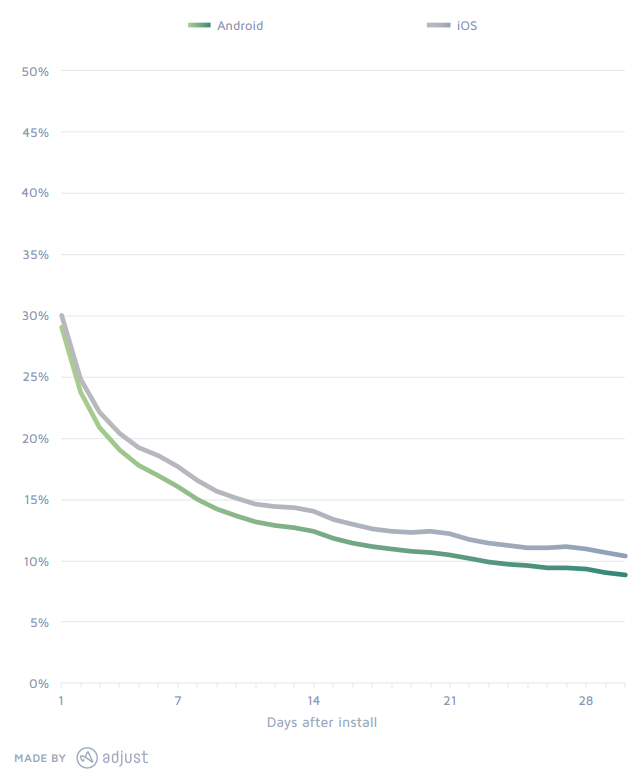
Let's now look at the statistics of returns in different markets. According to statistics, the most "responsible" users in Japan - their presence in applications on the 30th day is about 3% more than in the United States or in Russia. Another situation with the situation in China, here the users return the least - on the 30th day you can see only about 3% of the people who originally installed the application:
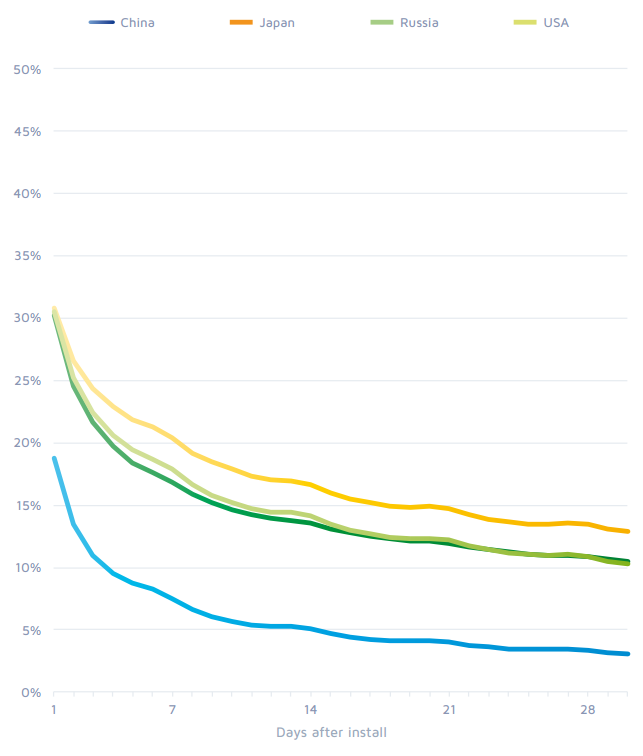
This can be explained as a large choice of applications in China, and the dominance of large platforms, like the same WeChat.
Let us analyze how users return to applications in different categories. Everything is also noticeably different here, both on the first day and at the end of the month. Entertainment applications are more sticky with 35% on Day 1 and 15% on Day 30. It is quite logical that less than 20% return to Travel apps and less than about 11% on Day 30:
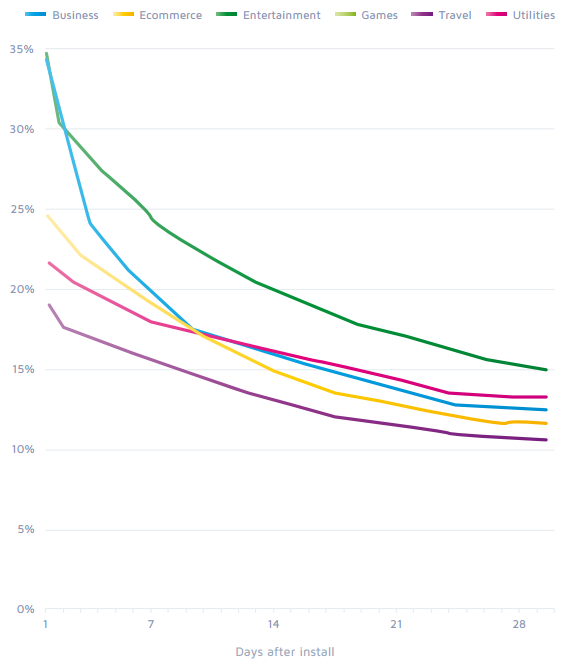
These were “average market” returns. Top applications work much better - you can find information about their performance in the Adjust report.
Where to get the “right” users is the second most important issue for a mobile developer and marketer.
This can be determined, for example, by the average number of sessions for users who come from one or another source. So, the users who generate the most sessions are delivered by the Google advertising network, Twitter is on the second place and Facebook is the third:

Each company determines the session in its own way. In this case, Adjust defines the session as a set of regular user actions within the application, separated by at least 30 minutes.
The “average number of sessions per user” metric is often used with returns to see how interested users are in the application, as well as to understand what they actually do in the product.
User sessions are not necessarily a key metric — it depends a lot on the structure of your application. For example, for a complex game with long sessions, multiple user visits every day are not at all mandatory, especially if they have already been converted into paying players. However, for most applications, many sessions mean a lot of interest.
As with any cohort indicator, it is helpful to analyze the sessions on specific days. As a rule, the number of sessions decreases with time, but it is interesting to consider this indicator in combination with others. Low returns but many sessions? Your application is niche, but if you find your audience, it will be very passionate about it. High returns but few sessions? Users probably find your app useful, but only once or twice a day in the situation they need.
If you look at the number of sessions by country, then Russia is among the leaders - with us the number of sessions with time is not something that does not fall, but is constantly growing. Look at Japan - here is the situation described above - good returns, but falling sessions, the audience is looking for useful applications:
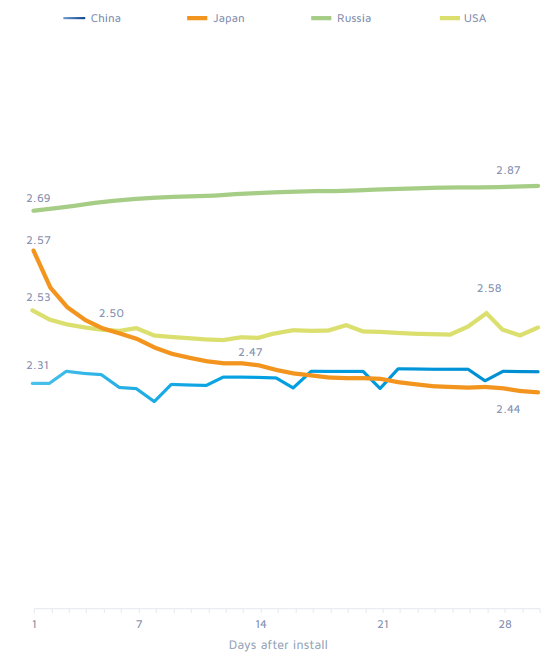
In the Eurozone in the leaders of the UK:
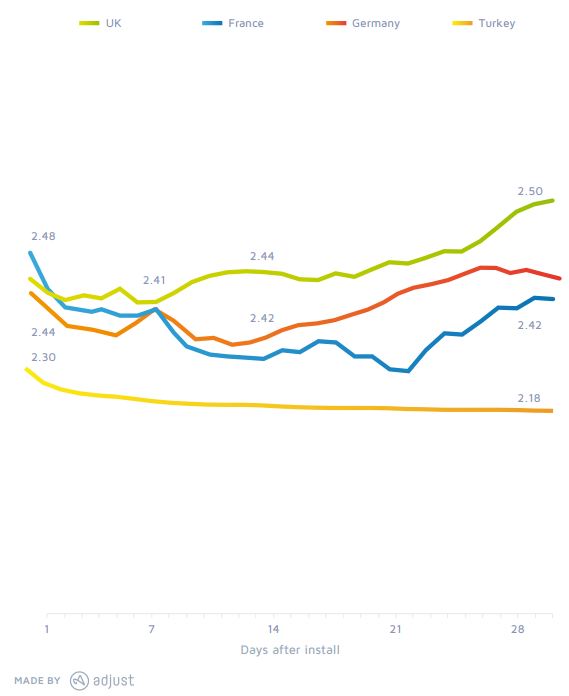
If we consider applications on verticals, then Utility leaders are obviously the most useful applications used every day. It is not difficult to assume that the bottom of the schedule will be Travel - applications that are used literally several times a month:
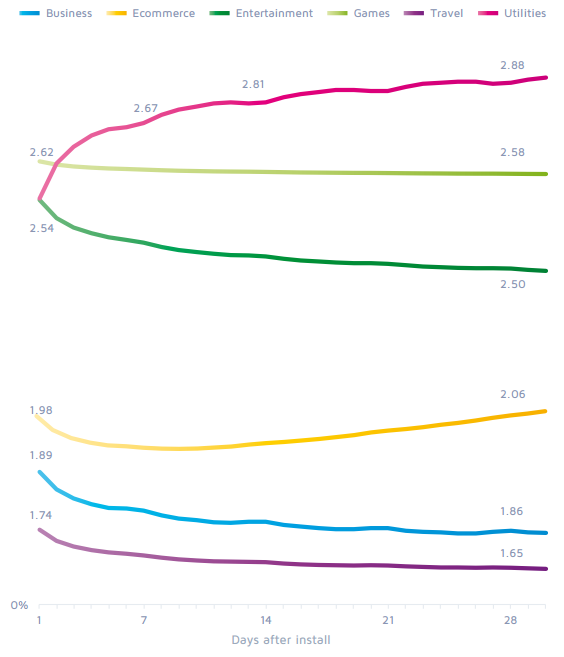
Mobile advertising fraud has long been considered a simple task , because often one campaign gets hundreds of thousands of clicks and a relatively small number of installations, which provides the perfect cover for potential fraudsters.
Until recently, the absence of sectoral measures in the fight against fraud meant that the offender is likely not to be caught, and therefore can act with a greater degree of impunity. How recent? Adjust was the first attribution provider to offer timely protection against fraud.
And the company is now sharing how many fraud are in different categories - for example, more than a third of the game installations are fraudulent:

The Android application is most susceptible - in 2017, Adjust prevented on this platform two times more cheating attempts than on iOS.
Returns and sessions are good, but the real goal of any marketer is to perform actions whose purpose is to pay, convert a user from free to paying.
Events by country - the leaders of the United States, and we close the top four with China:
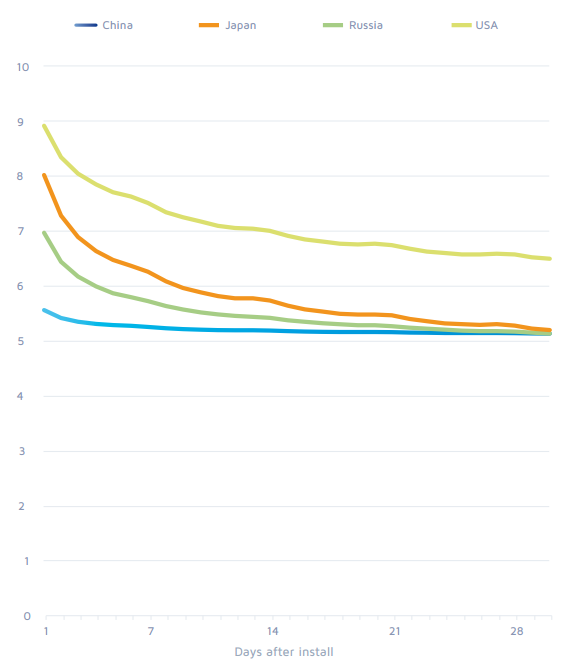
Events in verticals - eCommerce has few returns, but in terms of events this category is evident in unconditional leaders. Games are lagging behind at times, but if the number of events at stores decreases over time, it is steadily increasing in games.
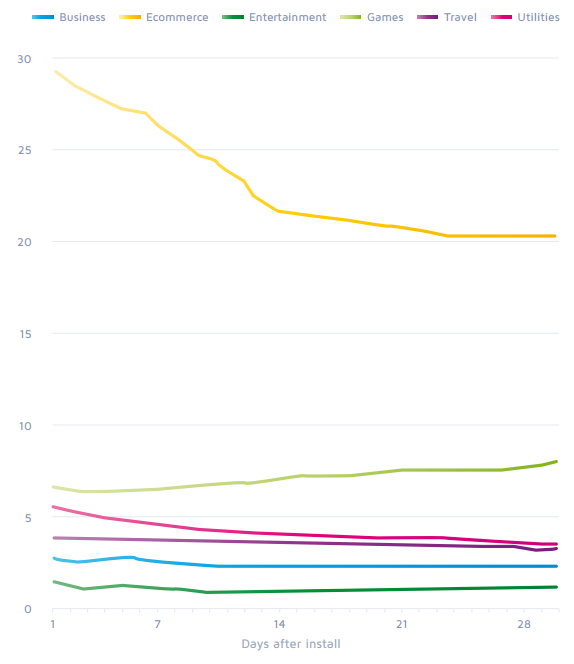
In the report, you can also find data for each month on returns in different categories and countries, the number of sessions and events by country.
You can download the entire report here .

Return users (Retention)
Returning users is one of the fundamental metrics that determine how much users liked the application after downloading. On returns to the application, a base of loyal users is built, they contain your ability to increase application revenue and LTV growth.
')
Returns show how many percent of users return to the application on a particular day after installation. A higher percentage of returns means that the application is more successful: more active and loyal users, more opportunities for monetization.
Here is how the average returns in applications by platform: iOS and Android start on Day 1 at about the same level of 30%, by Day 7 they diverge by 2 percentage points (18% and 16%, respectively) and continue to maintain this gap up to Day 30, when average returns fluctuate around 10%:

Let's now look at the statistics of returns in different markets. According to statistics, the most "responsible" users in Japan - their presence in applications on the 30th day is about 3% more than in the United States or in Russia. Another situation with the situation in China, here the users return the least - on the 30th day you can see only about 3% of the people who originally installed the application:

This can be explained as a large choice of applications in China, and the dominance of large platforms, like the same WeChat.
Let us analyze how users return to applications in different categories. Everything is also noticeably different here, both on the first day and at the end of the month. Entertainment applications are more sticky with 35% on Day 1 and 15% on Day 30. It is quite logical that less than 20% return to Travel apps and less than about 11% on Day 30:

These were “average market” returns. Top applications work much better - you can find information about their performance in the Adjust report.
User Sources
Where to get the “right” users is the second most important issue for a mobile developer and marketer.
This can be determined, for example, by the average number of sessions for users who come from one or another source. So, the users who generate the most sessions are delivered by the Google advertising network, Twitter is on the second place and Facebook is the third:

Sessions
Each company determines the session in its own way. In this case, Adjust defines the session as a set of regular user actions within the application, separated by at least 30 minutes.
The “average number of sessions per user” metric is often used with returns to see how interested users are in the application, as well as to understand what they actually do in the product.
User sessions are not necessarily a key metric — it depends a lot on the structure of your application. For example, for a complex game with long sessions, multiple user visits every day are not at all mandatory, especially if they have already been converted into paying players. However, for most applications, many sessions mean a lot of interest.
As with any cohort indicator, it is helpful to analyze the sessions on specific days. As a rule, the number of sessions decreases with time, but it is interesting to consider this indicator in combination with others. Low returns but many sessions? Your application is niche, but if you find your audience, it will be very passionate about it. High returns but few sessions? Users probably find your app useful, but only once or twice a day in the situation they need.
If you look at the number of sessions by country, then Russia is among the leaders - with us the number of sessions with time is not something that does not fall, but is constantly growing. Look at Japan - here is the situation described above - good returns, but falling sessions, the audience is looking for useful applications:

In the Eurozone in the leaders of the UK:

If we consider applications on verticals, then Utility leaders are obviously the most useful applications used every day. It is not difficult to assume that the bottom of the schedule will be Travel - applications that are used literally several times a month:

Frode
Mobile advertising fraud has long been considered a simple task , because often one campaign gets hundreds of thousands of clicks and a relatively small number of installations, which provides the perfect cover for potential fraudsters.
Until recently, the absence of sectoral measures in the fight against fraud meant that the offender is likely not to be caught, and therefore can act with a greater degree of impunity. How recent? Adjust was the first attribution provider to offer timely protection against fraud.
And the company is now sharing how many fraud are in different categories - for example, more than a third of the game installations are fraudulent:

The Android application is most susceptible - in 2017, Adjust prevented on this platform two times more cheating attempts than on iOS.
Events and Conversion
Returns and sessions are good, but the real goal of any marketer is to perform actions whose purpose is to pay, convert a user from free to paying.
Events by country - the leaders of the United States, and we close the top four with China:

Events in verticals - eCommerce has few returns, but in terms of events this category is evident in unconditional leaders. Games are lagging behind at times, but if the number of events at stores decreases over time, it is steadily increasing in games.

In the report, you can also find data for each month on returns in different categories and countries, the number of sessions and events by country.
You can download the entire report here .
Source: https://habr.com/ru/post/352006/
All Articles